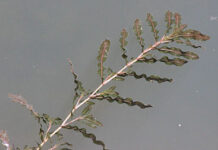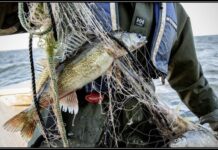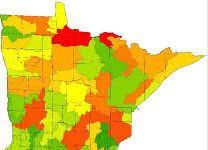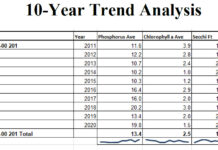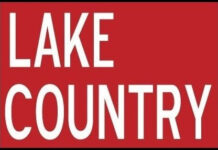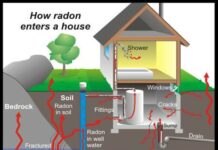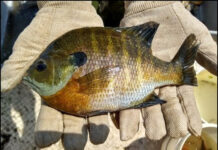For more information: lakehelp2@gmail.com
Lake Improvement District (LID) Voting
This article refers to data sourced from Otter Tail County, MN. Data received from other MN counties will be formatted differently but this article presents a viable approach for equitably counting votes at LID meetings in all MN counties.
What is a Lake Improvement District (LID)?
A LID is a local governmental unit, a political subdivision, established by resolution of a county board, city council or by the commissioner of the department of natural resources. A LID allows for greater local involvement in lake management activities. See the article on the DNR website HERE.
Management of a LID is dependent on a board of Directors. Each LID must have an annual meeting of property owners. At annual meetings Directors are elected, the budget for the upcoming year is approved, individual projects costing more than $5,000 are approved and other District business is discussed.
Property owners in attendance at annual meetings vote on Directors, required approvals as well as other appropriate motions that may be offered.
Registration of votes requires consideration. Counting votes of all meeting attendees may not be considered equitable. Can a husband and wife who jointly own a property be able to register 2 votes? Can a family of parents and children be able to register each of their votes? How are trusts, partnerships, commercial properties handled?
A logical, equitable approach to recording property owner votes is to recognize only one person to vote at meetings for each account used by the County for tax assessment billings. This one vote can be termed a “Voting Authority”.
Otter Tail County has established a table of categories they use to identify types of properties. This grouping begins to help in defining a Voting Authority.
Categories
- CHARITABLE INS- Charitable Institution
- COMM LAND & BLDGS- Commercial ownership
- COMM SEAS REC RES- Commercial Seasonal and Recreational
- MA & PA RESORTS- Small resorts
- MISC-NOT REPORTED
- MUNICIPAL PUB-OTHER
- NON-PROFIT COMM(NON)
- PROP W/ZERO VALUE
- RES 1-3 UNITS
- RESIDENTIAL
- SEASONAL RES REC- Seasonal Residence Recreational
- STATE ACQUIRED
Fields
Within Categories Several data Fields are used to further determine a Voting Authority.
- PIN- Parcel Identification Number. The PIN is the basic property unit for the County.
- ClsDes1- Class Description 1. Tax category assigned to the Parcel (PIN)
- MP_Nbr1- Number that groups PINs together for a Voting Authority
- Choice1- Sequential sub numbers for MP_Nbr1
- MSortnm- Main Sort Name. Registered name associated with the property or property group on tax records.
- PhyAddr1- Physical address of property on the lake
- MULT- This Field is not included in the
file received from the County but is a computed tag that is extracted from the
MSortnm Field. The MULT Field will
identify any property where the MSortnm contains “TST”, “LLC”, “ET AL”, “&”,
etc.
- Any MSortnm that contains any of these tags is a fairly dependable clue that there may be more than one person that might be eligible to possess the Voting Authority for the property or property group.
Explanation of how Categories determine Voting Authority status
This explanation may appear overwhelming without referring to actual data that has been sorted and organized. For assistance contact lakehelp2@gmail.com
- CHARITABLE INS
- Fields used
- MP_Nbr1 of 0
- Choice1 of 099
- PINs
- PhyAddr1s
- Only one MSortnm is designated as CHARITABLE INS. Since all of these PINS are adjacent, this MSortnm gets only one Voting Authority.
- Fields used
- COMM LAND & BLDGS
- Mp_nbr1 groups PINs together for the Voting Authority
- Choice1 shows PINs that are combined for MP_Nbr1 number and are by themselves not used to identify a Voting Authority
- MSortnm is the name assigned to the property
- MULT indicates if there may be more than one person that might be eligible to be the Voting Authority for the property or group of properties.
- COMM SEAS REC RES
- Only one MSortnm is designated as COMM SEAS REC RES. The one PIN present, this entity gets only one Voting Authority.
- MA & PA RESORTS
- MP_Nbr1is used to group PINs together for Voting Authority.
- Each MP_Nbr1 is eligible for one Voting Authority
- MISC-NOT REPORTED
- Appears to not qualify for a Voting Authority
- MUNICIPAL PUB-OTHER
- Appears to not qualify for a Voting Authority
- NON-PROFIT COMM(NON)
- Appears to not qualify for a Voting Authority
- PROP W/ZERO VALUE
- Appears to not qualify for a Voting Authority
- RES 1-3 UNITS
- All MP_Nbr1 are 0
- Choice1 are all 099
- Some MSortnm show multiple PINs. They appear to be adjacent PINs. If PINs are adjacent all of the PINs should be grouped together for one Voting Authority.
- MULT indicates if there may be more than one person that might be eligible to be the Voting Authority for the property or group of properties.
- RESIDENTIAL
- RESIDENTIAL refers to “Homestead” properties. They refer to the primary residence for taxing purposes.
- MP_Nbr1>0, Choice1>000
- Each MP_Nbr1 designates a Voting Authority
- MULT indicates if there may be more than one person that might be eligible to be the Voting Authority for the property or group of properties.
- SEASONAL RES REC
- SEASONAL RES REC refers to non-“Homestead” properties and not considered the primary residences for taxing purposes.
- The Choice1 Field is actually not used as they appear very seldom in the data.
- Where there are multiple PINs for MSortnm, the PINs need to be reviewed to see if they are adjacent to one another. Where PINs are adjacent they should be grouped together for one Voting Authority. Where they are not adjacent (for example the same MSortnm may have properties on opposite sides of the lake), Each PIN or groups of PINS that are adjacent will each be given a separate Voting Authority.
- MULT indicates if there may be more than one person that might be eligible to be the Voting Authority for the property or group of properties.
- STATE ACQUIRED
- Appears to not qualify for a Voting Authority
How to handle administration of multiple candidates for Voting Authority
When there is more than one person that might be eligible to be the Voting Authority the property or group of properties needs to designate one person to vote on its behalf in elections. This can be done by registration of that person with the LID Secretary for this purpose.
There are a majority of situations where it appears that a husband and wife are joint owners of a property or group of properties. Although they are limited to only one Voting Authority elections can be managed to allow either the husband or wife to have the Voting Authority. This provision can be extended to other family or partner couples.
For assistance in analyzing a LID database for determination of Voting Authority contact lakehelp2@gmail.com
For more information go to the DNR LID website HERE

